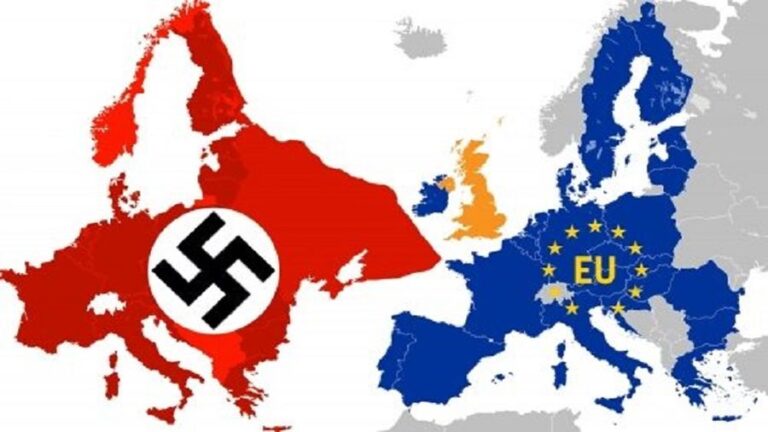The Ukraine Arms Drain
After months of feigned confidence and optimism from both the West and Ukraine’s senior military leadership, cracks are beginning to appear. During Ukrainian Commander-in-Chief General Valery Zaluzhny’s recent interview with the Economist, Ukraine’s desperate need for additional arms and the consequences for not receiving them was made very clear.
The discussion revolved around the desperate need for resources – everything ranging from air defense missiles to tanks, armored vehicles, artillery pieces and artillery shells themselves – all things that both the West and now Ukraine are admitting are in short supply, and perhaps cannot be supplied any time in the near or intermediate future.
From “Extending Russia” to “Demilitarizing” NATO
Washington’s proxy war against Russia in Ukraine is the manifestation of the RAND Corporation’s 2019 paper “Extending Russia” which recommended US policymakers to “provide lethal aid to Ukraine” hoping it would expand hostilities in eastern Ukraine and “increase the costs to Russia, in both blood and treasure, of holding the Donbass region.”
The paper had hoped that Russian losses in equipment and lives in the Donbass would replicate the costs the Soviet Union suffered in Afghanistan. While the Russian Federation is indeed facing mounting costs in Ukraine, it can easily be argued that the US, the rest of NATO, and most of all – Ukraine itself – are suffering at least as much if not more.
What’s perhaps more important than how much either side is losing in the conflict is how much either side can afford to lose because of their respective military industrial capacity to regenerate manpower and equipment throughout the fighting. After nearly a year of fighting, it is clear that Russia’s stockpiles and military were prepared for this type of protracted, intense, large-scale military conflict. Ukraine and its Western sponsors were not.
Ukraine’s General Zaluzhny shared with the Economist a “wishlist” of weapons he claimed he needed in order to restore the February 23, 2022 borders of what Kiev claims is Ukraine. The list included 300 tanks, 600-700 infantry fighting vehicles, and 500 howitzers – numbers NATO couldn’t provide Ukraine no matter how much it wants to.
This “wishlist” follows Ukraine expending a massive reserve made up of weapons, vehicles, and ammunition the collective West transferred to Ukraine ahead of the so-called Kharkov and Kherson offensives. In addition to losing multiple brigades worth of men, huge amounts of equipment were also lost as Russian ground forces withdrew and instead used long-range weapons to strike at Ukrainian forces now out from behind well-laid defenses.
The temporary political points Ukraine’s offensives gained by taking territory came at the cost of expending the vast majority of what the West could afford to transfer to Ukraine.
A growing number of admissions are now being made regarding the limits of Western aid to Ukraine.
A November New York Times article titled, “U.S. and NATO Scramble to Arm Ukraine and Refill Their Own Arsenals,” admits:
Last summer in the Donbas region, the Ukrainians were firing 6,000 to 7,000 artillery rounds each day, a senior NATO official said. The Russians were firing 40,000 to 50,000 rounds per day.
By comparison, the United States produces only 15,000 rounds each month.
So the West is scrambling to find increasingly scarce Soviet-era equipment and ammunition that Ukraine can use now, including S-300 air defense missiles, T-72 tanks and especially Soviet-caliber artillery shells.
While General Zaluzhny wants 300 tanks, the US has only managed to scrape together 90 T-72 tanks which require refurbishment. They are expected to arrive in Ukraine by the end of the year according to US government media outlet Radio Free Europe/Radio Liberty.
The 500 howitzers required by Zaluzhny do not exist in NATO stockpiles. But even if they did, the 155mm rounds they fire are in short supply. The New York Times in its article claims that Ukraine had been firing between 6,000 to 7,000 rounds a day versus Russia’s 40,000 to 50,000, illustrating the disparity between Ukraine and its Western backers’ stockpiles and Russia’s.
US drawdown packages for Ukraine often exclude additional 155mm rounds for the M777s and other artillery pieces it and the rest of NATO provided Ukraine. This is because stockpiles are running low as the US produces only 15,000 rounds per month – or about as many rounds as Ukraine typically fires in 2-3 days.
Ramping up production will take years. The US is arranging procurement of additional arms and ammunition to replace what has been transferred to Ukraine. However these procurement plans fall far short of reaching the levels necessary to continue providing Ukraine what it needs to maintain its current fighting capacity.
An article by Breaking Defense published recently listed a number of munitions and weapon systems the US will be procuring over the course of the next several years. The number of artillery shells that will be acquired through this multi-year procurement process number only 864,000 – or about as many shells as Ukraine will fire in less than half a year.
Current US procurement plans do not seem to factor in long-term support for Ukraine, nor are there any procurement plans being discussed that will. While Russia claims that “demilitarizing” Ukraine is one of its primary objectives during its ongoing special military operation, it appears that the US and NATO are also – in a way – being demilitarized.
As Ukraine Runs Dry, Russian Weapons Continue to Arrive
In the face of Ukraine’s two major fall offensives, Russian forces not only maintained their fighting capacity, after a partial mobilization calling up over 300,000 additional troops, Russia’s fighting capacity has actually expanded. In addition to the extra manpower, Russia is also bringing in a steady flow of new weaponry.
As the US scrapes together 90 restored T-72 tanks, it is reported by Army Recognition that up to 200 brand new T-90 main battle tanks were delivered to the front.
While the New York Times discusses the dwindling number of arms and ammunition being sent by the West to Ukraine, it admits (citing Ukrainian officials) that Russia may be making at least 40 cruise missiles per month, though the number is likely much higher.
A steady stream of Geran-2 long-range kamikaze drones continue “arriving” in Ukraine even after Western analysts claimed Russia ran out of them. The cruise missiles and drones have been used to target Ukraine’s power grid while other long-range munitions as well as heavy artillery fire continue eliminating Ukrainian manpower and equipment from the battlefield.
Production numbers across Russia’s vast, mostly state-owned military industrial complex remain elusive, but based on how Russia’s stockpiles were created specifically for large-scale, intense, and protracted military conflict and how Russia’s military has likewise been configured to conduct such military conflict, it is highly likely extensive preparations were also made years in advance for Russia’s military industrial complex to produce what is necessary for such military conflict.
Only time will tell just how prepared Russia was and is to sustain combat operations against the combined resources of the US and its NATO allies. What is certain is that Ukraine’s fall offensives have ground to a halt while Russian forces are now once again inching across the battlefield.
It is worth mentioning that General Zaluzhny during his Economist interview would say:
I get what I get, but it is less than what I need. It is not yet time to appeal to Ukrainian soldiers in the way that Mannerheim appealed to Finnish soldiers. We can and should take a lot more territory.
General Zaluzhny may not think it’s time to appeal to Ukrainian troops regarding their surrender to Russia as Mannerheim did to Finnish soldiers while capitulating to the Soviet Union, in the hopes that the West will provide what Zaluzhny thinks he needs to win, but it is clear that the West neither has what he needs to win, nor is making any serious preparations to acquire it.
The only hope – it appears – rests with the notion that Russia will run out of weapons and ammunition before Ukraine’s dwindling supplies are finally exhausted. It is a hope that is shaken each time a new Russian cruise missile or drone strikes Ukrainian infrastructure across the country, or each time a brand new T-90 main battle tank rumbles into the Donbass region.







